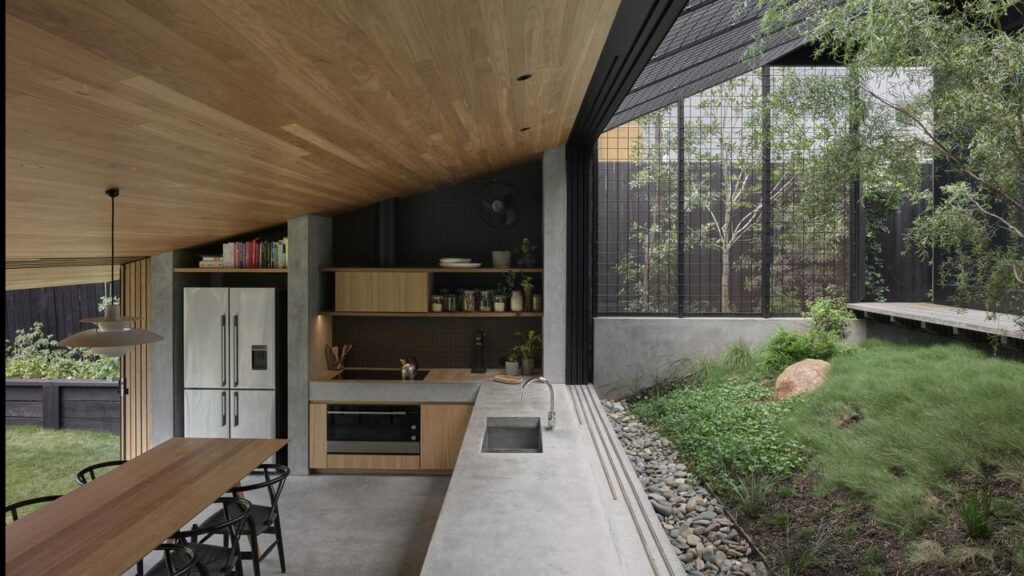Japanese courtyard Queenslander leads design winners
Liz Hobday |

A renovation that draws on Japanese courtyard design to update a traditional Queenslander is among the winners at the National Architecture Awards.
Architect John Ellway was tasked with extending an early 1900s timber cottage and connecting the building to its backyard, but was faced with a drop of more than two metres between house and garden.
He turned to the Japanese concept of Niwa – a small cultivated courtyard – to bring light into the house and tie it to the surrounding environment.

Steps from the main part of the house lead to the screened garden, which features a native Weeping Tea Tree, and down to a kitchen area that opens onto the backyard.
Niwa House is one of 30 winning designs at the awards announced in Canberra on Thursday night.
The 30 sq m Niwa House extension was designed to fit solar panels, batteries, and rainwater harvesting tanks, and the residents decided to open up their front garden too.
“It’s a place where they can sit and have a coffee and chat to neighbours – they wanted to actually be part of their neighbourhood, which is a nice thing, isn’t it?” Ellway said.

Also recognised with an award for enduring architecture was the Uluru-Kata Tjuta Cultural Centre which opened in 1995, its two buildings representing ancestral snake creatures that battled at a nearby waterhole.
Taken together, the winning designs show how architecture can help address problems such as climate change, housing shortages, and the cost of living crisis, said jury chair Jane Cassidy.
“These residential, community, and commercial buildings represent the very pinnacle of contemporary design, and importantly are true innovators addressing our most urgent societal challenges,” she said.

In the 2025 awards, affordability was a key criterion, with entries demonstrating that high quality designs don’t have to be very expensive, according to Cassidy.
Some entries represent housing solutions that could be rolled out quickly and affordably across Australia, she said.
KEY WINNERS AT THE NATIONAL ARCHITECTURE AWARDS
* Harry Seidler Award for Commercial Architecture – Northern Memorial Park Depot by Searle x Waldron Architecture
* National Award for Commercial Architecture – Everlane Cremorne by Fieldwork
* Educational Architecture – The Shed, University of Tasmania by Wardle, St Joseph’s Catholic Primary School Rosebery by Neeson Murcutt Neille
* Enduring Architecture – Uluru-Kata Tjuta Cultural Centre by Gregory Burgess
* Lachlan Macquarie Award for Heritage – Parliament of NSW Restoration by Tonkin Zulaikha Greer and Purcell Architecture
* National Award for Heritage – Australian War Memorial New Entrance and Parade Ground by Studio.SC
* Sir Zelman Cowen Award for Public Architecture – Yarrila Place by BVN
* National Award for Public Architecture – Truganina Community Centre by Jasmax, Eva and Marc Besen Centre by Kerstin Thompson Architects
* The Eleanor Cullis-Hill Award for Residential Architecture – Niwa House by John Ellway
* National Award for Residential Architecture – Houses (Alterations and Additions) – Gunn Ridge House by Kennedy Nolan and The Stopover by Taylor Buchtmann Architecture
* Robin Boyd Award for Residential Architecture – Houses (New) – Hedge and Arbour House by Studio Bright
* National Award for Residential Architecture – Houses (New) – Mapleton House by Atelier Chen Hung, New Castle by Anthony St John Parsons, Lagoon House by Peter Stutchbury Architecture
AAP


